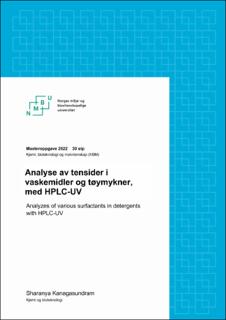| dc.contributor.advisor | Ekeberg, Dag | |
| dc.contributor.advisor | Devle, Hanne Marie | |
| dc.contributor.author | Kanagasundram, Sharanya | |
| dc.date.accessioned | 2023-01-26T13:50:12Z | |
| dc.date.available | 2023-01-26T13:50:12Z | |
| dc.date.issued | 2022 | |
| dc.identifier.uri | https://hdl.handle.net/11250/3046639 | |
| dc.description.abstract | Tensider er et samlenavn for overflateaktive stoffer som i økende grad blir anvendt ved mange industriområder som mat-, farmasøytisk og den kjemiske industrien. Blant disse har tensider en stor rolle innen husholdningsprodukter som vaskemidler, tøyvask, tøymyknere, hygieneprodukter med fler (Farn, 2006). For produsenter av slike husholdningsprodukter er det viktig å vite hvilke typer tensider som benyttes i de forskjellige produktene. Dette er en utfordring på grunn av manglende informasjon fra leverandørene av tensidene (Tadros, 2014).
I denne oppgaven ble en metode utviklet og validert for bestemmelse tensidene natrium laureth sulfat (SLES), dipalmitoyletyl hydroksyetylmonium metosulfat (DHM), lauraminoksid og etoksylerte alkhol tensider som tilhører ulike tensidklasser, ved bruk av high performance liquid chromatography (HPLC) med UV-vis som detektor. Analysen var utført på en Acclaim surfactant kolonne, med stasjonærfase som består av både omvendtfase- og ionebytterkromatografi. Metoden bestod av gradient separasjon med mobilfasene metanol og 0,1M ammoniumacetat buffer ved pH 5, kjørt på 25% til 80% metanol ved ulike tider for de tilhørende tensidene. Gradienten separerte DHM-komponentene i den kationiske tensidklassen. Dette som følge av at DHM-tensidene hadde høyere UV-absorbanse ved 209 nm, i forhold til metanol som absorberte ved 205 nm. Konsentrasjon av kationiske tensidene som var tilstede i tøymykner, ble funnet til å være 1,8 +/- 0,2 mg/mL av tensid DHM-C16, og 2,5 +/- 0,2 mg/mL for DHM-C18. Tensidklassene anioniske, amfotære og ikke-ioniske kunne ikke kvantifiseres med metoden, fordi tensidene absorberer ved lavere bølgelengder under 205 nm.
En indirekte fotometrisk metode ble benyttet som følge av at enkelte tensidklasser ikke kunne kvantifiseres. Det anioniske tensidet SLES ble valgt for metoden, med MPI som visualiseringsreagens. Mobilfase bestod av 70% acetonnitril, 30% vann og 0,25 mM MPI reagens, separert på en C18-kolonne. Metoden ytet en tilfredsstillende linearitet over et stort konsentrasjonsområde ved standardkurven for tensidstandardene, R2- verdi på 0,9979. Kvantifisering av SLES tensidet i tøyvask viste en konsentrasjon på 0,570 +/- 0,008 mg/mL. For andre tensidklasser som amfotære og ikke-ioniske tensider, bør det gjøres en vurdering på metoden som ble utprøvd i utgangspunktet, og utføre analyser på alternativ detektor som en ELSD detektor for produkter som inneholder flere tensider. | en_US |
| dc.description.abstract | Surfactants are increasingly used in many industrial areas such as food, pharmaceutical and chemical industries. Among these, surfactants play a major role in home and personal care products such as detergents, laundry detergents, fabric softeners, hygiene products and many more (Farn, 2006). For manufacturers of household products, it is important to know the surfactants are used in the following products. This becomes a challenge due to a lack of information from the suppliers of the surfactants (Tadros, 2014).
In this thesis a qualitative method was developed and validated for the determination of four surfactants belonging to different surfactant groups, known as sodium laureth sulfate (SLES), dipalmitoylethyl hydroxyethylmonium methosulfate (DHM), lauramine oxide and ethoxylated alcohol. By performing the analysis on a high-performance liquid chromatography (HPLC) with UV-vis as detector. The method was tested on an Acclaim surfactant column, with a stationary phase consisting of both reversed-phase and ion-exchange chromatography. The method consisted of gradient separation with the mobile phase methanol and 0.1M ammonium acetate buffer at pH 5. The gradient separated one of the surfactant class of cationic surfactants DHM-C16 and DHM-C18. And could be quantified since the surfactants had higher UV absorbance at 209 nm compared to the methanol, which absorbed at 205 nm. Concentration of cationic surfactants present in fabric softener was determined to be 1,8 ± 0,2 mg/mL of surfactant DHM-C16, and 2,5 ± 0,2 mg/mL of DHM-C18. Anionic, amphoteric and non-ionic surfactant classes could not be quantified, since maximum absorbance for the surfactants where lower than of methanol cut-off absorbance value at 205 nm.
An indirect photometric method was tested as a result of the fact that certain surfactant classes could not be quantified. The anionic surfactant SLES was chosen for this method, with MPI as the visualization reagent. Mobile phase consisted of acetonitrile, water and 0.25 mM MPI reagents, and separated with a C18-coloumn. The method provided good linearity over a large concentration range of surfactant standards, R2 value at 0.9979. Quantification of the SLES surfactant in laundry showed a concentration of 0.570 ± 0.008 mg/mL. For other surfactant classes such as amphoteric and non-ionic surfactants, an evaluation should be made on the method that was initially tested, and to be analyzed on an alternative detector such as an ELSD detector especially for products containing several surfactants. | en_US |
| dc.language.iso | nob | en_US |
| dc.publisher | Norwegian University of Life Sciences, Ås | en_US |
| dc.rights | Attribution-NonCommercial-NoDerivatives 4.0 Internasjonal | * |
| dc.rights.uri | http://creativecommons.org/licenses/by-nc-nd/4.0/deed.no | * |
| dc.title | Analyse av tensider i vaskemidler og tøymykner, med HPLC-UV | en_US |
| dc.title.alternative | Analyzes of various surfactants in detergents with HPLC-UV | en_US |
| dc.type | Master thesis | en_US |
| dc.description.localcode | M-KB | en_US |

